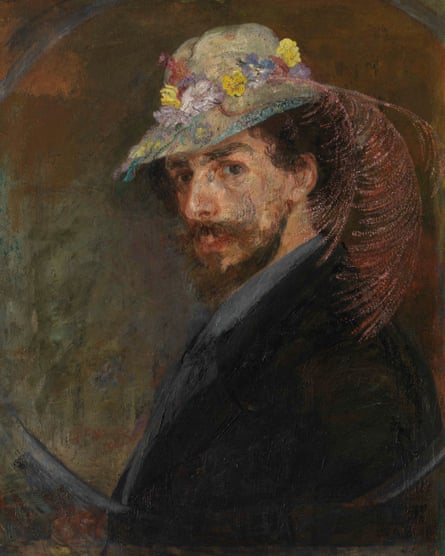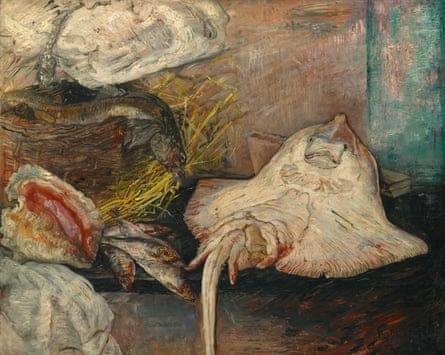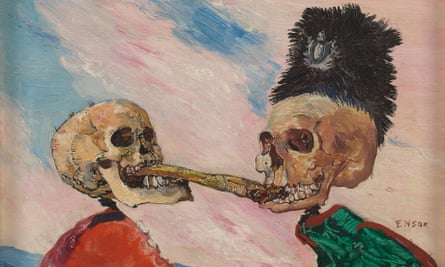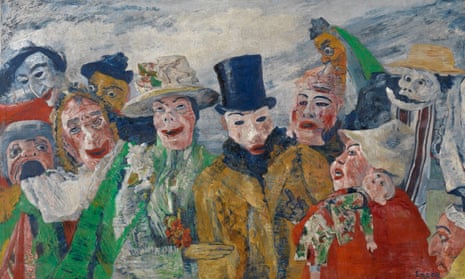In 1888 the still-young James Ensor etched a self-portrait “in the year 1960”. Accompanied by an outsize spider (Ensor hated spiders), the 100-year-old artist’s skeleton lounges casually on a divan, the skull sprouting remnants of his thick, curly hair. As so often with this playful master of the macabre, the moods of the cabaret and mortuary collide. In contrast, his actual resting place looks rather staid.
Just outside the pretty medieval church of Our Lady of the Dunes, on the edge of Ostend’s seaside sprawl, the tomb of Baron James Ensor (the king of Belgium ennobled the veteran mischief-maker in 1929) keeps itself aloof and apart – as the artist did during a long life spent in the North Sea fishing port turned holiday resort. In 2006, however, one of the mammoth spiders sculpted by Louise Bourgeois and entitled Maman disturbed his peace when it came to squat over his grave during Ostend’s Beaufort festival of art. Ensor, who had as troubled a relationship with maternal figures as he did with arachnids, should have enjoyed the joke.
This month Ensor will take a starring role in Britain for the first time in two decades when Intrigue: James Ensor by Luc Tuymans opens at the Royal Academy. Curated by Tuymans, Belgium’s subversively deadpan master of figurative painting, the exhibition gathers 70 paintings, drawings and prints, mostly from Belgian collections. Ensor had an English father, retained his British nationality until he scented the prospect of a Belgian title, loved Turner, Gillray and Hogarth, and once wrote: “I feel more English than most of the English artists now slavishly imitating the early Italians.” (He detested the pre-Raphaelites, along with the impressionists, pointillists and almost every other late 19th‑century school.) But his father’s country has not paid enough attention to the great maverick – at least since, three years before his death, aged 89, in 1949, the National Gallery displayed a selection of his works.

The RA show will rectify that neglect, even if the proud, prickly Ensor might have pointed out that he has to play second fiddle to the abstract expressionist blockbuster now running at the same address. Tuymans calls this juxtaposition “a beautiful contradiction”. Ensor, who in 1911 boasted that he had “anticipated all modern tendencies … in every direction”, would probably claim paternity of Jackson Pollock, too. Look, for instance, into the delirious vortex of burnt and scorched colours of his Fall of the Rebel Angels (1889), and you might be tempted to agree.
You could stuff a student textbook with the “isms” that Ensor arguably pioneered, from surrealism – always at home in Belgium – to symbolism, expressionism, fauvism, even post-modernism. A stylistic nomad, he not only roved among landscape, portraiture, still life, fantasy, satire and caricature, but often whisked them together into a tipsy burlesque of skewed and addled forms. In The Skate (1892), a still life with seafood morphs into a bizarre quasi-erotic reverie, the flatfish splayed like an odalisque as the seashell exposes its crimson gash. Critics always yoke Ensor to the spirit of the carnival – a big deal everywhere in Belgium, and in Ostend in particular. Yet his whirling panoply of masks, costumes and disguises dances on the edge of nightmare more often than it summons up a spell of careless joy.
In The Intrigue (1890), which lends Tuymans’s show its title, a gang of freakishly masked faces converge on a couple – she with a flowered hat, he in a topper – in a livid parody of bonhomie rendered in violent slabs of clashing colours. Death, in a yellow hat, saunters in stage-right. As in Edvard Munch’s near-contemporary vision of ghostly evening strollers on Karl Johan Street in Oslo – and Ensor does regularly bring Munch to mind – these rituals of middle-class sociability have been hatched in hell. It was once thought that the painting depicts Ensor’s beloved sister Mitche and her Chinese husband, who later abandoned her, but the pair met only after its creation. Ensor’s bilious dismay at the bourgeois dance of death needed no external prompts.

A visit to Ostend, his lifelong home and yet the abode in his eyes of “a hostile public” that “detests art”, helps to focus the tensions that drove Ensor’s brush. As a sparkling late-summer day dips towards sunset, the ever-changing flash and gleam of sea and sky reminds you that Ensor worshipped light as deeply as Turner did. For him, “light distorts contour”, and its myriad effects in bending line and shape opened “an enormous realm that I could explore”. However, a few paces away from this shimmering seafront, the door of the Ensor House opens on to a scene of gloom and fret. These dark interiors conditioned his outlook as much as the boundless shores outside. Ensor inherited the narrow house on Vlaanderenstraat from his aunt and uncle in 1917, and moved out of his parents’ (now destroyed) home across the street.
His English father, a well-educated man but known in Ostend as an idler and drinker, had settled on this coast after he married Marie Catherine Haegheman. Her family owned curio shops that catered for the town’s crowds of trippers and vacationers. The carnival masks, seashells, dolls, knick-knacks and oriental vases that made up the Haeghemans’ stock cram Ensor’s works. This repertoire of domestic exotica feels more sinister than picturesque. Skulls and skeletons – often added to finished works as a mocking appendix – also fill the idiosyncratic prop box of imagery that he rifled throughout his career. As much as it did for his medieval Flemish and Netherlandish forebears in the age of Bosch and Brueghel, death leads this carnival parade.
The wastrel father encouraged young James in his artistic career; the hard-headed mother and aunt, less so. Ensor never married, although he kept up a decades-long liaison with a local innkeeper’s daughter, Augusta Boogaerts, and later grew close to patrons and supporters such as the writer Emma Lambotte. After 1903, Lambotte helped his trademark works of the 1880s and 90s find buyers and acclaim. She wrote warmly of her friend as “a skinny Don Quixote sporting the goatee of a valiant Spaniard … tall, with dark curls, a pale skin, a piercing glare, moustache in the wind”. His occasional air of raffish misogyny – common enough among the late-Victorian avant garde – seems to conceal a fearful solitude. Eccentric, opinionated, the future Baron Ensor at once played to the gallery and skulked in the wings. In the claustrophobic house on Vlaanderenstraat, both stage set and hidey-hole, you can sense the lure of the mask to a cowed rebel imprisoned in a stuffy dressing-up box.
Ostend suited this gregarious loner. From 1883 to 1893, after his studies in Brussels, he helped spearhead the group of Belgian progressive artists founded by Octave Maus and known as The Twenty (Les XX) – but fell out with them, as with other allies. In Ostend, he first resented but then befriended another local talent: Léon Spilliaert, whose haunting and introspective night-pieces complement Ensor’s more garish palette in a wing dedicated to the pair at the town’s fine museum, Mu.ZEE.
At home, he could swagger along the front, a frock-coated, acid-tongued lord of misrule, ready with a quip but quick to take offence. For all his versatility, and his innovation, Ensor expended too much time and talent on feuds and quarrels. His Goya-like caricatures often revert to his spats with the critics, as in Skeletons Fighting Over a Pickled Herring. He is the hapless fish, torn between two long-forgotten arbiters of taste. No one now cares about the parochial row that fuelled this piece; the image endures in its dream-like weirdness, set against a rosy Ostend sky.

Tuymans, his co-curator Adrian Locke reports as we lunch in a cafe-gallery above the sands, “wanted to look at Ensor with a critical eye. It’s not all about adulation and admiration.” Brilliantly executed, grotesque and provocative, Ensor’s antic performances transmit the contradictions of a scurrilous satirist who craved status and respect. “He was definitely anti-establishment in that he was not prepared to accept the norms,” says Locke. “On the other hand, he had a family who were willing to support him.” Here, on the margins of his society and gazing out across the sea he never crossed (save for a brief visit to London), the local hero alchemised the art he admired – from Rembrandt and Rubens to Goya and Turner – into something strange and unique. For Locke, “The enigma of Ensor is that he looked at other artists, and was influenced by them, but distils this so that it comes out in a very different way.” In the end, Ensor neither follows nor sires any “ism”.
Aged 28, the curmudgeonly renegade painted the vast Entry of Christ into Brussels in 1889, with its swirling, threatening rabble of masked figures around a saviour who has the features of … James Ensor. Confined to his attic studio, Ensor couldn’t even unroll the entire 2.5 metre x 4.3 metre canvas until he inherited the house on Vlaanderenstraat almost 30 years later. Since 1987, it has hung in the Getty Museum in Los Angeles – which it never leaves. In bulk, Ensor’s sepulchral dandyism and morbid vaudeville can repel as well as fascinate, for all its virtuoso dazzle. Then, as in the radiant Adam and Eve Expelled from Paradise (1887), the North Sea light will blaze through the cynicism. At such moments, the solitary scoffer transports us from Ostend to eternity.

Comments (…)
Sign in or create your Guardian account to join the discussion